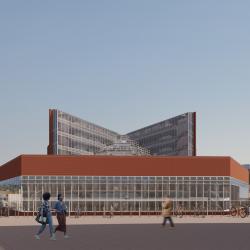Our long-term vision for the University’s estate – connecting people
To support the University’s academic mission by developing facilities and links that better connect people
(a) across our estate, (b) within our sites, (c) inside our buildings.
By delivering higher quality and more welcoming places that encourage collaboration and promote an inter-connected community of scholars, we will improve academic outcomes in a way that also uses our estate more intensively.
This will create vibrant spaces that will improve both the staff and student experience and their wellbeing in a way that is more enjoyable and supportive for all our people, as well as being more biodiverse and sustainable, all at a lower cost, enabling reinvestment back into research and teaching.
We will achieve this by:
- Creating a more effective, efficient and environmentally sustainable estate by implementing our Strategic Estate Framework (cam-only) and the associated Strategic Estate Capital Plan that supports the future development of the estate.
- Delivering world-class, safe and compliant teaching, research, and operational spaces across the University by operating and maintaining buildings and facilities to a high standard.
- Providing innovative and more intensively used spaces whilst also delivering strong financial returns for the University by managing the commercial and residential estate enabling academic and business partnerships.
- Enabling the University to deliver against its environmental commitments by leading the environmental sustainability agenda and improving the environmental performance of the estate, climate change readiness and associated operations, covering carbon, energy, water, waste, transport, and biodiversity as well as adapting the estate.
Our team:
The staff in the Estates Division are responsible for the development, management and maintenance of one of the largest higher education estates in the UK.
Find out more about what we do on the Developing our Estate and Estate Operations pages. Explore our work to improve the environmental sustainability of our operational estate.
Our estate:
The University’s operational estate is used for teaching, research and supporting administrative functions. The University’s Strategic Estate Framework (cam-only) outlines the long-term vision and strategic direction for the University of Cambridge’s operational estate.
In addition, the University holds a significant non-operational property portfolio which includes residential buildings, commercial properties (such as leisure and retail spaces), sports facilities, infrastructure including roads and parking, as well as major development projects, such as the University’s strategic housing development at North West Development (Eddington) and the establishment of a world-class innovation district at Cambridge West.
Each year we submit information about our estate, including the total number of operational buildings and the total site area of our operational estate, to Higher Education Statistics Agency (HESA) which can be found here. The Colleges are independent of the University estate.


